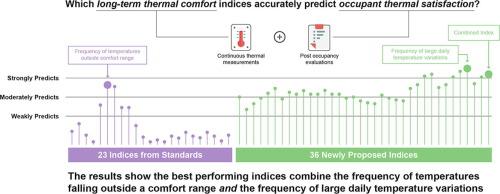Energy and Buildings ( IF 6.7 ) Pub Date : 2020-07-03 , DOI: 10.1016/j.enbuild.2020.110270 Peixian Li , Thomas Parkinson , Stefano Schiavon , Thomas M. Froese , Richard de Dear , Adam Rysanek , Sheryl Staub-French

|
Thermal comfort standards have suggested a number of physical indices which can be calculated from either building simulations or in situ physical monitoring to assess the long-term thermal comfort of a space. However, the prohibitively high cost of sensor technologies has limited the applications of these physical indices, and their usefulness has never been established using data collected in real buildings. This paper is the first assessment of the six types of existing indices (23 total) found in standards and five types of new indices (36 total) and their correlation with the long-term thermal satisfaction of building occupants. Correlation analyses were based on continuous thermal comfort measurements and post-occupancy evaluation surveys from four air-conditioned office buildings in Sydney, Australia. We found that the majority of existing indices, especially those based on predicted mean vote (PMV) and predicted percentage dissatisfied (PPD) metrics, have a weak correlation with thermal satisfaction. The percentage of time outside a temperature range was the best-performing index from the standards (). A new index based on the percentage of time that daily temperature range is greater than a threshold reported the strongest correlation () with thermal satisfaction for this dataset. The results suggest that occupants’ long-term thermal comfort is influenced more by pronounced excursions beyond some acceptable temperature range and large variations in daily temperature than the average experience over time. These findings support the use of continuous monitoring technologies for long-term thermal comfort evaluation and inform potential amendments of international thermal comfort standards.
中文翻译:

改进的长期热舒适指数,可进行连续监控
热舒适标准建议了许多物理指标,这些指标可以通过建筑模拟或就地计算得出物理监视以评估空间的长期热舒适度。然而,传感器技术的高得惊人的成本限制了这些物理指标的应用,并且从未使用在真实建筑物中收集的数据来确定其有用性。本文是对标准中发现的六种现有指标(共23种)和五种新指标(共36种)的首次评估,并将它们与建筑物居住者的长期热满意度相关。相关性分析基于对澳大利亚悉尼四座空调办公楼的连续热舒适度测量和占用后评估调查。我们发现大多数现有指数,特别是那些基于预测平均投票(PMV)和预测不满意百分比(PPD)指标的指数,与热满意度之间的相关性较弱。温度范围外的时间百分比是标准中表现最好的指标()。根据每日温度范围大于阈值的时间百分比得出的新指数报告了最强的相关性()对该数据集的热满意度。结果表明,与长期的平均经历相比,超出某些可接受的温度范围和日间温度变化较大的明显偏移对乘员的长期热舒适性的影响更大。这些发现支持将连续监测技术用于长期热舒适性评估,并为国际热舒适性标准的潜在修订提供信息。


























 京公网安备 11010802027423号
京公网安备 11010802027423号